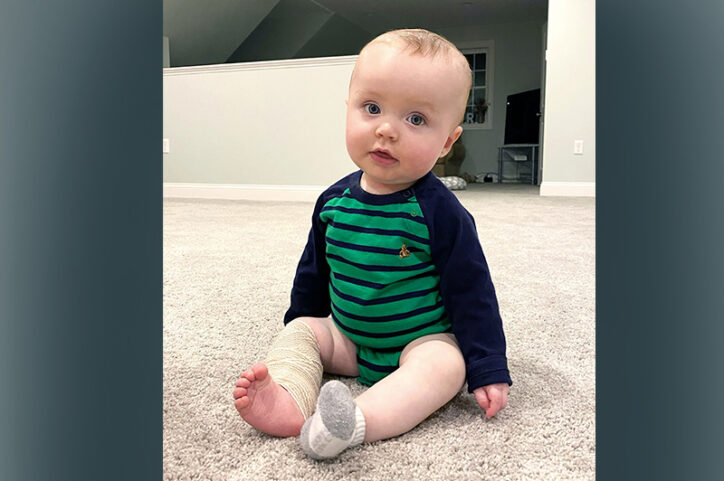Understanding and treating Mason’s congenital nevus

Kim and Ryan noticed their son’s birthmark almost immediately after he was born. They knew birthmarks were common, but Mason’s was different — it covered a large portion of his right leg and calf. Their doctor classified it as a giant congenital melanocytic nevus and suggested they monitor it closely, but that didn’t answer all their questions.
“We didn’t know what it meant,” Kim says. “We were scared because we had no idea if it was cancerous or a sign of another condition.”
Congenital nevi are a type of birthmark a person is born with. They’re rare — affecting about 1 in 20,000 children— and can vary in size, shape, and color. These nevi often require careful monitoring, and sometimes surgery to prevent complications.
Options for treatment
Kim and Ryan turned to Boston Children’s Hospital, where Kim had received care as a child.
“You can’t beat Boston Children’s when it comes to where you want to send your baby,” Kim says. “Having such a fantastic hospital right in our backyard made it an easy choice.”
After meeting with the team in Boston Children’s Dermatology Program, they were referred to Dr. Ingrid Ganske, a plastic surgeon in Boston Children’s Department of Plastic and Oral Surgery.
Mason had his first consultation with Dr. Ganske when he was just a few months old, and she explained the available treatment options. One approach was to wait and monitor the nevus as Mason grew; the other was to surgically remove it while he was still an infant. Early removal, when Mason’s skin was more adaptable, would help minimize scarring and help avoid more extensive procedures, such as a skin graft (taking skin from another area of the body) or a tissue expander (stretching the skin to create extra tissue for reconstruction) — both of which would require longer recovery times.
“We wanted to be thoughtful about it,” Kim says. “We didn’t want to wait too long because as Mason grew, so would the nevus,” Kim says. “But putting your baby through surgery is really hard. Dr. Ganske allowed us to sit with each option and make our own decision.”
A phased approach to surgery, guided by compassion

Ultimately, Kim and Ryan decided on surgery. When Mason was 6 months old, Dr. Ganske removed the darker areas of the nevus, as these areas often have more pigment than the rest of the nevus and can indicate abnormal cell growth. A biopsy confirmed no signs of cancer. Dr. Ganske removed the remaining nevus in two more procedures when Mason was 10 and 15 months. Her phased approach ensured Mason’s skin could heal properly between each operation.
Mason was in a full leg cast for a few weeks after his final surgery, but he was back to his busy, active self as soon as the cast came off. And despite incisions that spanned most of his lower leg, he has minimal scarring.
“You would never even know he had a scar,” Kim says.
A healthy recovery brings peace of mind
Today, Mason’s busy with preschool, sports, being a big brother, and an insatiable curiosity for dinosaurs, race cars, and books. Seeing him thrive brings Kim and Ryan incredible joy — and gratitude for their tough decision almost five years ago.
“Doing the surgeries as young as we did was the right decision for us,” says Kim. “It gives us comfort knowing the nevus is fully removed. And Dr. Ganske was spot on that his skin would heal beautifully.”
Looking back on the experience, Kim adds, “His recovery was unlike anything I could have expected. I wouldn’t change a thing about the process.”
Learn more about the Department of Plastic and Oral Surgery and Dermatology Program at Boston Children’s Hospital.
Related Posts :
-

What you should know about hemangiomas, according to a pediatric dermatologist
When parents discover that their infant has a hemangioma, a lot of questions usually follow. To find answers for the ...
-

Guided by her own experience, one mom navigates Stickler syndrome with her children
Aimee is more than just Mum to three-year-old Arwen and one-year-old Cedric; she’s their guide to navigating Stickler syndrome, ...
-

A partner through amniotic band syndrome: Jace’s story
Jace is a happy, energetic 9-month-old whose big brown eyes light up a room. He’s adored by his parents, ...
-

Keeping up with the tween skin care trend: What's in those products?
More teens and tweens are hitting the mall to grab skin-care products they’ve seen on social media — but are ...





